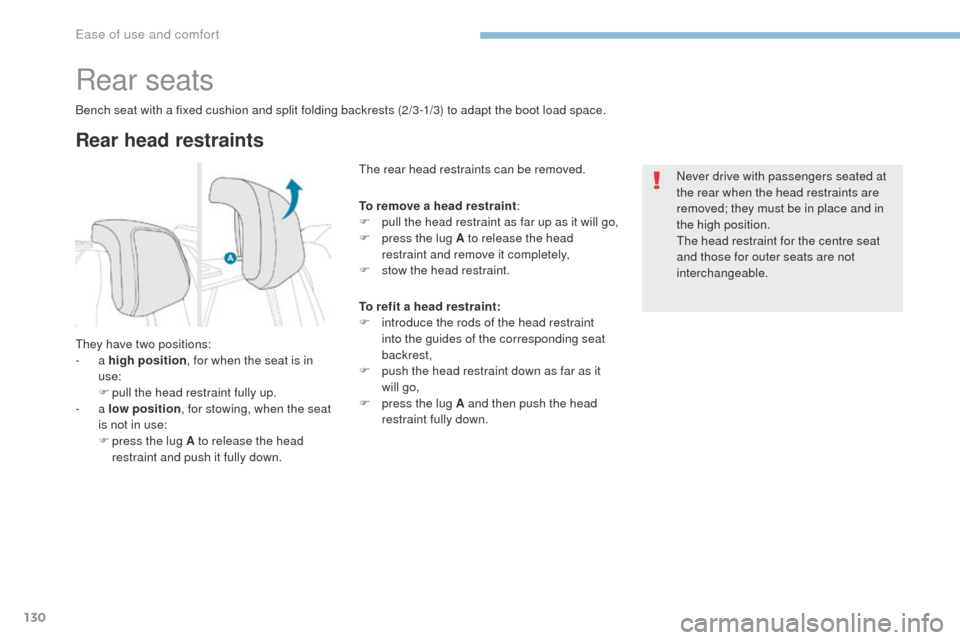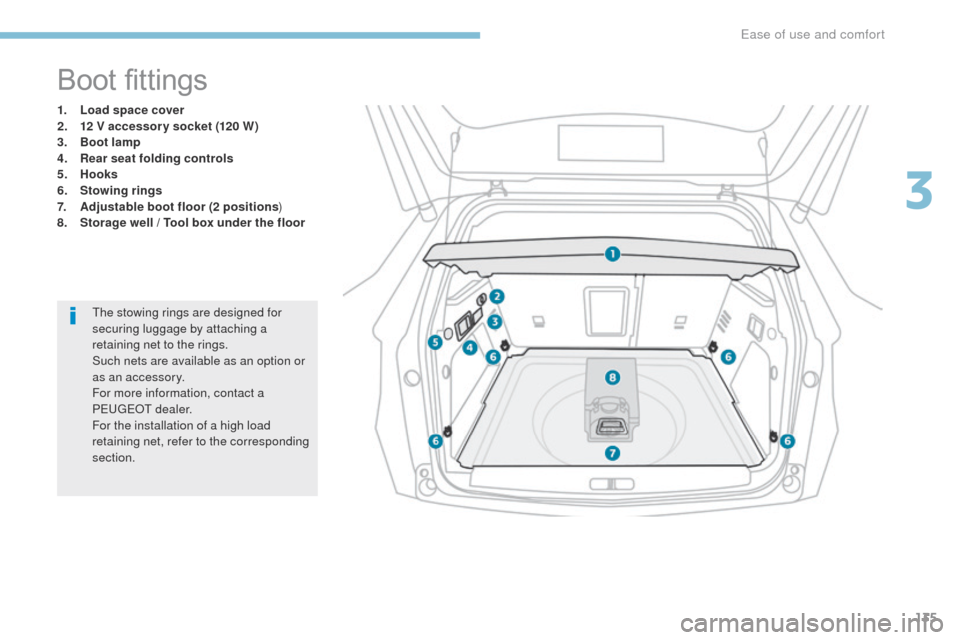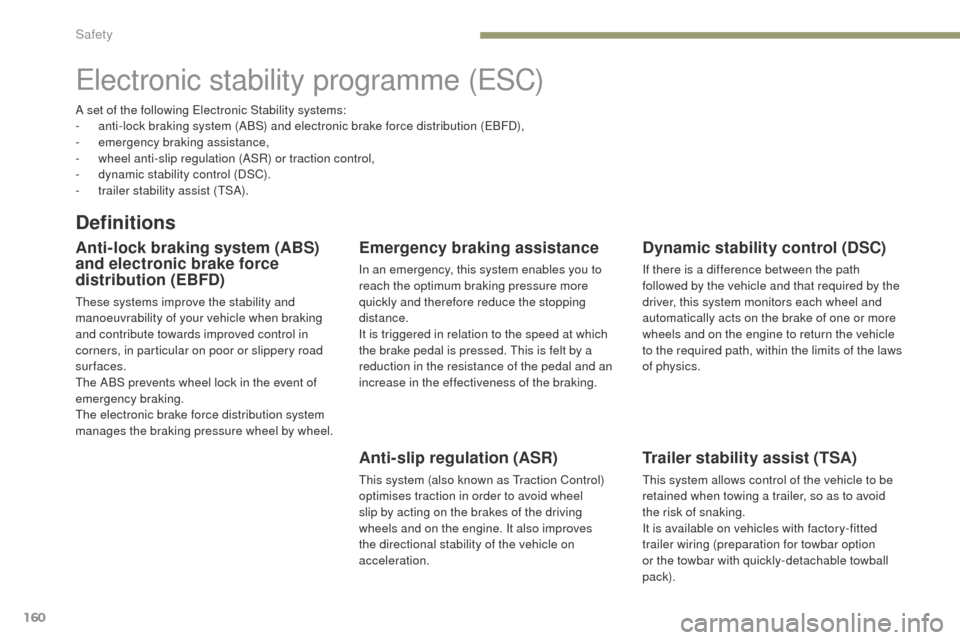2017 Peugeot 3008 Hybrid 4 towing
[x] Cancel search: towingPage 5 of 566

.
3008-2_en_Chap00a_sommaire_ed01-2016
For the audio and telematic systems,
refer to the supplement to the handbook
or go to the following internet address:
http://public.servicebox.peugeot.com/ddb/
Driving recommendations
1
95
Starting / Switching off the engine with the key
1
97
Starting / Switching off the engine with Keyless Entry and Starting
2
00
Electric parking brake
2
03
Manual gearbox
2
10
Automatic gearbox
2
11
Hill start assist
2
16
Dynamic Pack
2
17
Gear shift indicator
2
18
Stop & Start
2
19
Under-inflation detection
2
23
Memorising speeds
2
26
Speed limit recognition
2
27
Speed limiter
23
1
Cruise control
2
34
Dynamic cruise control with Stop function
238
Distance alertandActive Safety Brake
2
47
Fatigue detection system
2
52
Lane Departure Warning System 2
54
Assisted Lane Departure Warning System
25
5
Blind Spot Monitoring System
2
60
Parking sensors
2
63
Panoramic vision
2
65
Park Assist
2
72 Fuel tank
2
81
Misfuel prevention (Diesel)
2
82
Towing a trailer
2
84
Towbar with quickly detachable towball
2
85
Energy economy mode
2
90
Very cold climate screens
2
91
Snow chains
2
92
Fitting roof bars
2
93
Bonnet
294
Petrol underbonnet layout
2
95
Diesel underbonnet layout
2
96
Checking levels
2
97
Checks
301
AdBlue
® and SCR system
(BlueHDi Diesel) 3 03
Warning triangle
3
07
Running out of fuel (Diesel)
3
08
Tool kit
3
09
Temporary puncture repair kit
3
12
Spare wheel
3
17
Changing a bulb
3
23
Changing a fuse
3
31
12 V battery
3
32
Towing the vehicle
3
36Petrol engines
3
38
Petrol weights
3
39
Diesel engines
3
40
Diesel weights
3
42
Dimensions
3
44
Identification markings
3
45
Driving
Practical information
In the event of a breakdown Technical data
Alphabetical index
Contents
Page 6 of 566

4
3008-2_en_Chap00b_vue-ensemble_ed01-2016
Towing 336-337
Very cold climate screens
2
91
Dynamic cruise control with Stop
function
23
8-246
Front parking sensors
2
63 -264
Park Assist
2
72-279
Front foglamps
1
42
Cornering lighting
1
51
Remote control key
5
4, 63 - 67
Locking / Unlocking
5
5 -57
Starting the engine
1
97-199
Automatic illumination of
headlamps
14
6 -147
Automatic headlamp dipping
1
49-150
Automatic rain sensitive wipers
1
55
Fatigue detection system
2
52-253
Lane Departure Warning System
2
54
Assisted Lane Departure Warning System
255-259
Speed limit recognition
2
27-230
Distance alert / Active Safety B r a ke
2
47- 2 51
Electric windows
8
2- 83
D o o r s
74
C
entral locking
6
8 - 69
Alarm
70-73
Electronic stability programme (ESC)
160 -163
Advanced Grip Control
1
64-165
Hill Assist Descent Control
1
66 -167
Main lighting
14
1, 143 -14 4
Adjusting the headlamp beam height
1
45
Changing front bulbs
3
23-327
Heated windscreen
1
17
Demisting the windscreen
1
16
Windscreen wiper
1
52-154
Visiopark 2
26
5-266, 269-271 Electronic key
5
4, 63 - 67
Hands-free access
5
8 - 62
Keyless starting
1
97, 200 -202
Exterior
Over view
Page 7 of 566

5
3008-2_en_Chap00b_vue-ensemble_ed01-2016
Roof bars 293
Panoramic opening sunroof 8 4- 87
Under-inflation detection
2
23-225
Tyre pressures
2
23, 315, 345
Snow chains
2
92
Visiopark 1 & 2
2
65 -271
Rear parking sensors
2
63-264 Child lock
19
3 -19 4
Towing
336-337
Towbar
1
96, 284
Quickly detachable towball
2
85 -289
Trailer stability assist
1
63Fuel tank
28
1-283
Misfuel prevention
2
82
AdBlue tank
3
03 -306
Door mirrors
9
9 -100
Guide-me-home / welcome lighting
14
6 -148
Blind Spot Monitoring System
26
0-262
Changing rear bulbs
3
28-330
Defrosting the rear screen
1
18
Rear wiper
15
3 -15 4
Boot
5
7, 59, 75
Hands-free tailgate access
7
6 - 81
Tools
309-311
Temporary puncture repair kit
3
12-316
Spare wheel
3
17-322
Exterieur
.
Over view
Page 107 of 566

105
3008-2_en_Chap03_ergonomie-et-confort_ed01-2016
Stop & Start
The heating and air conditioning
systems only work when the engine is
running.
To maintain a comfortable temperature
in the passenger compartment, you can
temporarily deactivate the Stop & Start
system.
For more information on Stop & Star t,
refer to the corresponding section.
In order for these systems to be fully effective, follow the operation and maintenance
guidelines below:
F
T
o obtain an even air distribution, take care not to obstruct the exterior air intake grilles
located at the base of the windscreen, the nozzles, the vents and the air outlets, as well
as the air extractor located in the boot.
F
D
o not cover the sunshine sensor, located on the dashboard; this is used for regulation
of the air conditioning system.
F
O
perate the air conditioning system for at least 5 to 10 minutes, once or twice a month
to keep it in per fect working order.
F
E
nsure that the passenger compartment filter is in good condition and have the filter
elements replaced regularly.
W
e recommend the use of a combined passenger compartment filter. Thanks to
its special active additive, it contributes to the purification of the air breathed by the
occupants and the cleanliness of the passenger compartment (reduction of allergic
symptoms, bad odours and greasy deposits).
F
T
o ensure correct operation of the air conditioning system, you are also advised to have
it checked regularly as recommended in the warranty and maintenance record.
F
I
f the system does not produce cold air, switch it off and contact a PEUGEOT dealer or
a qualified workshop.
When towing the maximum load on a steep gradient in high temperatures, switching off the
air conditioning increases the available engine power and so improves the towing ability. The condensation created by the air
conditioning results in a discharge
of water under the vehicle which is
perfectly normal.
If after an extended stop in sunshine,
the interior temperature is very
high, first ventilate the passenger
compartment for a few moments.
Put the air flow control at a setting high
enough to quickly change the air in the
passenger compartment.
The air conditioning system does not
contain chlorine and does not present
any danger to the ozone layer.
Recommendations for ventilation and air conditioning
3
Ease of use and comfort
Page 132 of 566

130
3008-2_en_Chap03_ergonomie-et-confort_ed01-2016
Rear seats
Rear head restraints
Bench seat with a fixed cushion and split folding backrests (2/3 -1/3) to adapt the boot load space.
They have two positions:
- a high position , for when the seat is in
use:
F
p
ull the head restraint fully up.
-
a low position , for stowing, when the seat
is not in use:
F
p
ress the lug A to release the head
restraint and push it fully down. The rear head restraints can be removed.
Never drive with passengers seated at
the rear when the head restraints are
removed; they must be in place and in
the high position.
The head restraint for the centre seat
and those for outer seats are not
interchangeable.
To remove a head restraint
:
F
p
ull the head restraint as far up as it will go,
F
p
ress the lug A to release the head
restraint and remove it completely,
F
s
tow the head restraint.
To refit a head restraint:
F
i
ntroduce the rods of the head restraint
into the guides of the corresponding seat
backrest,
F
p
ush the head restraint down as far as it
will go,
F
p
ress the lug A and then push the head
restraint fully down.
Ease of use and comfort
Page 137 of 566

135
3008-2_en_Chap03_ergonomie-et-confort_ed01-2016
Boot fittings
1. Load space cover
2. 12 V accessor y socket (120 W)
3.
B
oot lamp
4.
R
ear seat folding controls
5.
Hoo
ks
6.
S
towing rings
7.
A
djustable boot floor (2 positions )
8.
S
torage well / Tool box under the floorThe stowing rings are designed for
securing luggage by attaching a
retaining net to the rings.
Such nets are available as an option or
as an accessory.
For more information, contact a
PEUGEOT dealer.
For the installation of a high load
retaining net, refer to the corresponding
section.
3
Ease of use and comfort
Page 159 of 566

157
3008-2_en_Chap05_securite_ed01-2016
Hazard warning lamps
Visual warning with all of the direction
indicators flashing to alert other road users to a
vehicle breakdown, towing or accident.
F
P
ress this button, all of the direction
indicators flash.
They can operate with the ignition off.
Automatic operation of
hazard warning lamps
When braking in an emergency, depending on
the force of deceleration, the hazard warning
lamps come on automatically. They switch off
automatically the first time you accelerate.
It is also possible to switch them off by pressing
the switch on the dashboard.
Horn
Audible warning to alert other road users to an
imminent danger.
F
P
ress the central part of the multifunction
steering wheel.
5
Safety
Page 162 of 566

160
3008-2_en_Chap05_securite_ed01-2016
Electronic stability programme (ESC)
Definitions
Anti-lock braking system (ABS)
and electronic brake force
distribution (EBFD)
These systems improve the stability and
manoeuvrability of your vehicle when braking
and contribute towards improved control in
corners, in particular on poor or slippery road
surfaces.
The ABS prevents wheel lock in the event of
emergency braking.
The electronic brake force distribution system
manages the braking pressure wheel by wheel.
Emergency braking assistance
In an emergency, this system enables you to
reach the optimum braking pressure more
quickly and therefore reduce the stopping
distance.
It is triggered in relation to the speed at which
the brake pedal is pressed. This is felt by a
reduction in the resistance of the pedal and an
increase in the effectiveness of the braking.
Anti-slip regulation (ASR)
This system (also known as Traction Control)
optimises traction in order to avoid wheel
slip by acting on the brakes of the driving
wheels and on the engine. It also improves
the directional stability of the vehicle on
acceleration.
Dynamic stability control (DSC)
If there is a difference between the path
followed by the vehicle and that required by the
driver, this system monitors each wheel and
automatically acts on the brake of one or more
wheels and on the engine to return the vehicle
to the required path, within the limits of the laws
of physics.
A set of the following Electronic Stability systems:
-
a
nti-lock braking system (ABS) and electronic brake force distribution (EBFD),
-
em
ergency braking assistance,
-
w
heel anti-slip regulation (ASR) or traction control,
-
d
ynamic stability control (DSC).
-
t
railer stability assist (TSA).
Trailer stability assist (TSA)
This system allows control of the vehicle to be
retained when towing a trailer, so as to avoid
the risk of snaking.
It is available on vehicles with factory-fitted
trailer wiring (preparation for towbar option
or the towbar with quickly-detachable towball
pack).
Safety